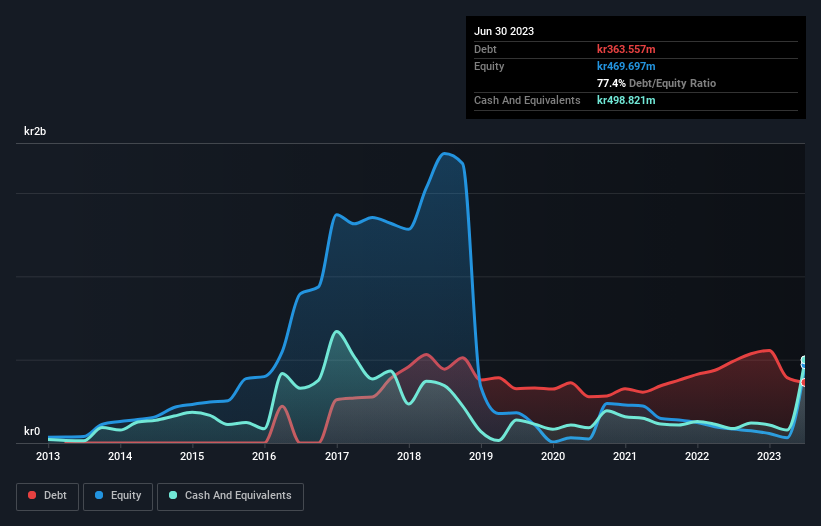The external fund manager backed by Berkshire Hathaway's Charlie Munger, Li Lu, makes no bones about it when he says 'The biggest investment risk is not the volatility of prices, but whether you will suffer a permanent loss of capital.' It's only natural to consider a company's balance sheet when you examine how risky it is, since debt is often involved when a business collapses. We can see that Starbreeze AB (publ) (STO:STAR B) does use debt in its business. But the real question is whether this debt is making the company risky.
When Is Debt A Problem?
Debt assists a business until the business has trouble paying it off, either with new capital or with free cash flow. In the worst case scenario, a company can go bankrupt if it cannot pay its creditors. However, a more frequent (but still costly) occurrence is where a company must issue shares at bargain-basement prices, permanently diluting shareholders, just to shore up its balance sheet. Of course, the upside of debt is that it often represents cheap capital, especially when it replaces dilution in a company with the ability to reinvest at high rates of return. When we think about a company's use of debt, we first look at cash and debt together.
Check out our latest analysis for Starbreeze
What Is Starbreeze's Debt?
The image below, which you can click on for greater detail, shows that Starbreeze had debt of kr363.6m at the end of June 2023, a reduction from kr489.3m over a year. However, it does have kr498.8m in cash offsetting this, leading to net cash of kr135.3m.

How Healthy Is Starbreeze's Balance Sheet?
Zooming in on the latest balance sheet data, we can see that Starbreeze had liabilities of kr755.0m due within 12 months and liabilities of kr2.64m due beyond that. On the other hand, it had cash of kr498.8m and kr33.2m worth of receivables due within a year. So it has liabilities totalling kr225.6m more than its cash and near-term receivables, combined.
Starbreeze has a market capitalization of kr676.0m, so it could very likely raise cash to ameliorate its balance sheet, if the need arose. However, it is still worthwhile taking a close look at its ability to pay off debt. Despite its noteworthy liabilities, Starbreeze boasts net cash, so it's fair to say it does not have a heavy debt load! There's no doubt that we learn most about debt from the balance sheet. But it is future earnings, more than anything, that will determine Starbreeze's ability to maintain a healthy balance sheet going forward. So if you're focused on the future you can check out this free report showing analyst profit forecasts.
Over 12 months, Starbreeze reported revenue of kr142m, which is a gain of 17%, although it did not report any earnings before interest and tax. We usually like to see faster growth from unprofitable companies, but each to their own.
So How Risky Is Starbreeze?
By their very nature companies that are losing money are more risky than those with a long history of profitability. And the fact is that over the last twelve months Starbreeze lost money at the earnings before interest and tax (EBIT) line. And over the same period it saw negative free cash outflow of kr98m and booked a kr25m accounting loss. While this does make the company a bit risky, it's important to remember it has net cash of kr135.3m. That kitty means the company can keep spending for growth for at least two years, at current rates. Summing up, we're a little skeptical of this one, as it seems fairly risky in the absence of free cashflow. The balance sheet is clearly the area to focus on when you are analysing debt. But ultimately, every company can contain risks that exist outside of the balance sheet. We've identified 4 warning signs with Starbreeze (at least 2 which are potentially serious) , and understanding them should be part of your investment process.
If you're interested in investing in businesses that can grow profits without the burden of debt, then check out this free list of growing businesses that have net cash on the balance sheet.
New: Manage All Your Stock Portfolios in One Place
We've created the ultimate portfolio companion for stock investors, and it's free.
• Connect an unlimited number of Portfolios and see your total in one currency
• Be alerted to new Warning Signs or Risks via email or mobile
• Track the Fair Value of your stocks
Have feedback on this article? Concerned about the content? Get in touch with us directly. Alternatively, email editorial-team (at) simplywallst.com.
This article by Simply Wall St is general in nature. We provide commentary based on historical data and analyst forecasts only using an unbiased methodology and our articles are not intended to be financial advice. It does not constitute a recommendation to buy or sell any stock, and does not take account of your objectives, or your financial situation. We aim to bring you long-term focused analysis driven by fundamental data. Note that our analysis may not factor in the latest price-sensitive company announcements or qualitative material. Simply Wall St has no position in any stocks mentioned.
About OM:STAR B
Starbreeze
Develops, publishes, and distributes PC and console games in Europe and North America.
Reasonable growth potential with adequate balance sheet.
Similar Companies
Market Insights
Community Narratives



